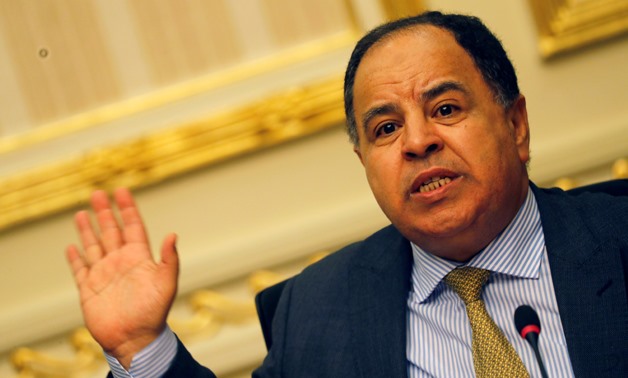
FILE PHOTO: Egypt's Finance Minister Mohamed Maait gestures during a news conference in Cairo, Egypt July 17, 2019. REUTERS/Amr Abdallah Dalsh/File Photo
CAIRO – 25 July 2021: Egypt’s Minister of Finance Mohamed Maait presented a number of important financial indicators related to improving economic growth rates, as the government succeeded in increasing state revenues by LE 119 billion, with a growth rate of 12.2 percent during 2020/2021.
Maait also noted Expenditures also rose by 9 percent, in addition to achieving a primary surplus in the budget of about 93.1 billion pounds, or 1.4 percent of GDP, while reducing the total deficit from 8 percent to 7.4 percent.
This came during the Minister’s meeting with President Abdel Fattah El-Sisi and the Prime Minister Mostafa Madbouly.
The official spokesman for the Presidency of the Republic stated that the meeting dealt with the review of the financial performance that was achieved for the fiscal year 2020/2021.
Maait also explained that Egypt came among the best countries in reducing the debt-to-GDP ratio, despite the Corona pandemic, which affected economic growth rates, revenues and expenditures and led many countries to increase debt rates.
“Egypt succeeded in raising the efficiency of public debt management by diversifying Its domestic and international instruments, and the debt-to-GDP in Egypt declined from 108 percent during 2016/2017 to 90.6 percent by the end of the fiscal year 2020/2021, in addition to the government’s success in extending the debt life from less than 1.3 years before June 2017, to 3.45 years in June 2021,” Maait noted.
He added that the cost of debt service was reduced from 40 percent of total expenditures during the fiscal year 2019/2020 to 36 percent during 2020/2021, with a target to reach 31.5 of total expenditures during the current fiscal year 2021/2022.
He also indicated that the total public investments during the current fiscal year 2021/2022 budget amounted to about LE 358.1 billion, as a result of the increase in investments funded by the public treasury at a rate of about 28 percent compared to the last fiscal year 2020/2021, so the total implemented government investments amounted to LE 289 billion, with an annual growth rate of more than 50.5 percent.
President Sisi directed to continue maintaining the rates of economic performance in order to stabilize the monetary and economic conditions of the country, while regularly checking and updating the mechanisms of governance of GDP data, not only to determine the indicators of financial performance, but to carefully monitor the size of all aspects of the comprehensive development process in Egypt, according to a financial system and integrated work mechanisms that clarify the actual reality of the development process and reflect the economic conditions in Egypt.
The Spokesman explained that the President directed to continue working on increasing financial allocations for public investments, in a way that helps enhance the volume of investments to meet development needs, within the framework of implementing the objectives of Egypt's Vision 2023 in order to lay the foundations for comprehensive and sustainable development.
The official spokesman added that the meeting witnessed a review of the most prominent existing projects to develop the customs system, including the single window project, and cooperation with various international agencies and institutions to raise the capabilities of Egyptian customs workers and improve trade facilitation practices, which contributed to the development of the average customs release time.
The President directed the completion of procedures for restructuring and modernizing the Customs Authority, including the development of human capabilities, in addition to the use of modern technologies in the governance of customs ports, as well as the development of technological infrastructure to ensure the connection between customs ports, as well as accelerating the automation of customs procedures and generalizing the single window system in all Ports and ports, with the aim of simplifying procedures and reducing customs release time, as well as unifying customs treatment at different ports, and reducing the cost of the import and export process.
The developments in the development of the tax system were also discussed, including the electronic tax invoice project, electronic tax returns, as well as efforts to automate the main tax work procedures, as well as the electronic receipts project. The axes of the future plan to continue developing the tax system were also presented, the most important of which are the legislative axis, the axis of digital transformation, the axis of combating evasion, the axis of settling tax disputes, the axis of infrastructure and headquarters, as well as the axis of human capacity development.
Comments
Leave a Comment